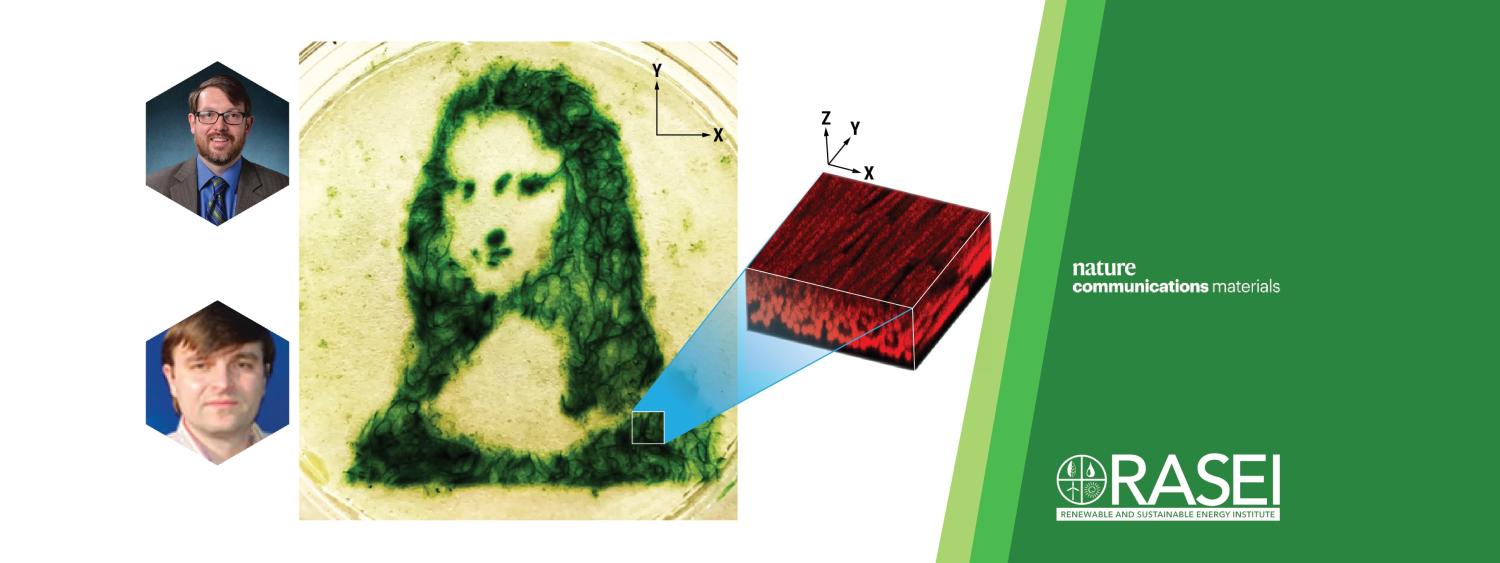
This collaboration, between a bacterial biochemist and a condensed-matter physicist, uses light to control the movement and arrangement of cyanobacteria, forming two- and three-dimensional nematic liquid crystalline states that could provide significant opportunities to regulate the behavior of the bacterial systems and open up new areas in bio-manufacturing that use carbon dioxide as the feedstock for the production of oxygen, biofuels, or biomaterials.
Cyanobacteria are one of the most ancient forms of life, dating back to ~3.5 billion years ago. Highly abundant, these bacterial dinosaurs use carbon dioxide and light as inputs and convert them to energy, motion, and oxygen. The term ‘Active Matter’ is used to describe systems that take in and dissipate energy at the level of constituent particles and, in the process, perform systematic movements. Essentially all forms of life can be considered active matter. Injecting energy into an active matter system often leads to emergent collective phenomena, think flocks of birds or schools of fish. Though there has been extensive research on the photosynthetic action of cyanobacteria, quantitative exploration of the motion, arrangement, and potential collective behavior of cyanobacteria is relatively unexplored. Intrigued by exploring these phenomena further, two RASEI Fellows formed an unusual partnership to investigate, and their findings are reported in this article in Nature Communications Materials.
In 2018 RASEI Fellows Jeff Cameron and Ivan Smalyukh were awarded a grant from the DOE to build a specialized microscope system for imaging photosynthetic microbes. The system includes an ultrafast laser system that enable multi-photon excitation in the pigments in the cyanobacterial cells, a technique that was essential for this investigation. Cameron, a member of the Department of Biochemistry, is an expert in cyanobacteria and photosynthesis, while Smalyukh, a member of the Department of Physics, is an expert in condensed matter physics, with a specialty in liquid crystals. The unusual nature of this partnership is not lost on them. “Normally Biochemistry and Physics are separated, making close collaboration difficult” explains Cameron, “especially when close experimental collaboration is needed, requiring routine access to environmental chambers and biological research labs as well as advanced laser labs”. A key feature in how RASEI is setup is the co-location of multidisciplinary researchers. Cameron notes “This enables researchers to work hand-in-hand on studies that would simply not be possible if the two labs were on opposite sides of campus”.
Working together the findings from this team were conclusive; the cyanobacteria danced to the light! When a localized light was introduced to the bacteria, they harvested energy from the light through photosynthesis and used the energy generated to move towards the light. Experiments were done in two modes, one where the bacteria were confined to a two-dimensional plane, and the second where they could move in three-dimensions. In the two-dimensional system as the density of bacteria in the colony increased in the illuminated area emergent collective behavior emerged, with the bacteria forming a nematic arrangement, similar to that observed in synthetic liquid crystals. This emergent behavior was found to develop dramatically over time, with the direction, orientation, and trajectory of the cyanobacteria all changing, thought to be driven by an optimization toward enhanced light energy intake. Expanding this to the three-dimensional studies the team found that the cyanobacteria stacked on top of each other to form 3D active nematic slabs. The specialized microscope system enabled the teams to effectively explore these three-dimensional structures, even looking at cross-sectional views of the emergent behaviors. Comprehensive studies explored a range of properties of these emergent ‘Flocks of Cyanobacteria’, including examining transitions between fluid and gel states, the impacts of introducing defects, interactions between polydomain systems, and movement around foreign objects.
Precise control of biological systems is the ‘holy grail’ in biomanufacturing. Spatial patterning of the cyanobacteria impacts the structural and functional properties of the bacteria. Cyanobacteria only require carbon dioxide, water, and light, and can produce biofuels, commodity chemicals, and minerals, all while pulling carbon dioxide out of the air and producing oxygen. Understanding, and more importantly being able to reliably control, the optimal conditions for these bio-manufacturing to operate has the potential to enable new avenues to utilize these biological systems in benefiting society and the environment.
Armed with an enhanced understanding of how these bacteria move and can be controlled by light, the team is excited by the possibilities. Smalyukh explains “Our discovery of out-of-equilibrium active matter phase transitions in filamentous cyanobacteria systems may find utility in commanding collective behavior of cyanobacteria, with potential biotechnological utility ranging from control of bacterial mats and blooms, to oxygen generation an inhibition of toxin production”. Cameron adds “the possibilities are endless-once we can control the growth and orientation of biology, we can create novel materials and start to think about entirely new, environmentally-friendly, biomanufacturing opportunities.”
There is something poignant when you consider employing these ancient lifeforms, that were responsible for the Great Oxidation Event, profoundly changing life as we know it, as active agents in pulling carbon dioxide, the key causative greenhouse gas in the climate crisis, out of our atmosphere. The understanding and control made possible through the investigations described here bring this one step closer.
